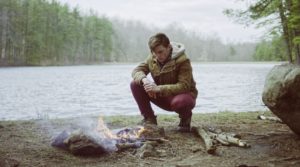Picture: Navaho sand painting to a Blessing Chant (Pollen Path). New Mexico, c. 1950
Have you ever experienced a “chance meeting” that changed the trajectory of your day, your career, or even your life? Or have you ever experienced a moment or series of moments when everything just clicked, coming together so smoothly you couldn’t have dreamed it being any more perfect? I certainly have, and maybe you have too. In these experiences, I couldn’t put my finger on what it was that caused the “planets to align” exactly, but when it happened, I could feel it. Sometimes I would use the terms happenstance and serendipity to describe what happened. Later in my life, a mentor introduced me to another way of understanding them, through sharing the Navajo “Pollen Path” teachings and ceremonial chant. These teachings really resonated with me.
The Navajo Pollen Path is depicted in a painting, one made of colored and painted sand, that represents an individual’s growth journey through life. In the painting, a person stands at the start of a path, and along the way are painted images of beings from the “spirit world,” the Navajo say, who support the individual. They come in the form of spiritual messengers arriving at critical times. If the individual is courageous enough to keep going and accept the help of the messengers, they will reach a place of peace or spiritual enlightenment. This is depicted in the painting in the form of a dove. Parts of the path representing moments of growth are painted as sprinklings of pollen.
The Navajo believe this experience of traveling the Pollen Path is circular, and when you complete your journey, you begin it once more along a new Pollen Path.
The Navajo people have a ceremonial chant in honor of this expereince:
“Oh beauty before me,
beauty behind me,
beauty to the right of me,
beauty to the left of me,
beauty above me,
beauty below me,
I am on the Pollen Path.
In the house of life I wander,
On the pollen path.”
When I read these words for the first time, I immediately remembered an experience in the mountains of Bulgaria.
I had been hitchhiking from the capital city of Sofia since the early morning. By late afternoon I had made it to the closest small town, cold, wet, hungry, and frustrated. I didn’t know how far my final destination—an Outward Bound school deep in the Rhodope Mountains—would be. So I asked the first person I met, an olive-skinned green-eyed college student I came across at the local tea shop. The school was “that way for a time,” she said. I remember pointing in the same direction, asking, “That way”? Then she shook her head. As an American, I understood that as no. But to Bulgarians it means yes. Confused I asked again. “School, that way?” I said. Again, a Bulgarian head shake of yes. Still confused, I asked “How far?” Getting a bit impatient with me, she answered, “Some time.” I thanked her, ordered hot tea, and found a seat outside so I could smoke a cigar and figure out my next move.
My irritation had been growing through the day. But as I sipped my tea and enjoyed my cigar, the astounding beauty around me began to melt away my frustration. I began to really see the rugged mountains and I marveled there were no swaths of timber disturbing the mountain sides. I also noticed an old man driving a horse-drawn cart with what looked like wooden fence posts stacked and tied down. When he would pass me, he would look in wonder. As he passed me for about the fourth time, I waved and motioned him to join me at my table. To which he raised his hand to his heart and said something that I couldn’t understand. He passed again and I repeated my gesture, again getting the same response. However, this time the green-eyed girl from another table interrupted. “He said he likes the smell of your tobacco and is asking for some.” Grateful for the translation, I said “of course” as I fumbled to opened up my backpack. Finding the cigars, I walked over and happily offered him three. His gap-toothed smile found its way through his unkept black beard and his eyes gleamed.
The girl and the cart driver began to speak. Soon the man was off his cart and gesturing for me to get on. The green-eyed girl said, “He wants to give you a ride to the school. He knows where it is.” I quickly accepted and finished my tea.
We rode together on the cart doing our best to understand each other. I showed him how to light the cigar the proper way, and he was grateful. Several times he would let loose a giggle from under his beard as if to say, “Look at me, I am smoking a cigar with an American headed into these beautiful mountains. Life is good today.” And it was.
When I heard the story of the Pollen Path, I thought of this experience because it was so defined by my taking in the beauty before me (and all around me). Once I began to see it, help came to me to support my journey, in the form of a horse drawn cart. I learned that day to let frustrations go and look for the beauty in a situation. This allowed me to connect with the man driving the cart. And, I got to where I needed to be in fine fashion.
The lesson of the Pollen Path is to understand that we are all on a journey, or in the Navajo’s terms, “in the house of life I wander.” And it’s during this journey we must have the courage to find the beauty in experiences. Doing so opens powers and energy far outside our understanding to gain wisdom that serves us the rest of our lives.
I’ve had a number of experiences like this over the years, as I keep retracing the Pollen Path. Have you had a similar experience you’d like to share? If so, how do you honor the beauty of that moment?




One Response
I allow my grief and sorrow, old and new, to surface with out escaping.